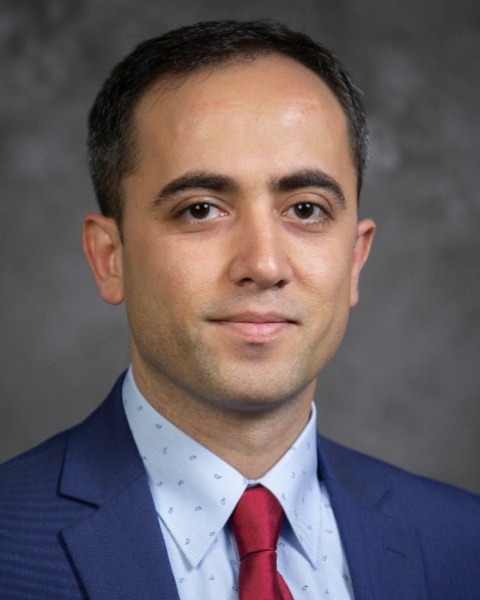Back
Poster Session C - Monday Afternoon
C0686 - Metastatic Gastric Cancer to the Rectum: A Systematic Review
Monday, October 24, 2022
3:00 PM – 5:00 PM ET
Location: Crown Ballroom

Dawood Findakly, MD
Feist-Weiller Cancer Center, Louisiana State University Health
Shreveport, LA
Presenting Author(s)
Introduction: Rectal metastasis (RM) from gastric cancer (GC) is an extremely rare entity. Herein, we review trends to promote detection and strategies for management.
Methods: PubMed search for "gastric cancer" and "rectal metastasis," from database inception through April 30, 2022; pooled with a case from our institution.
Results: We included 25 cases with a female:male ratio of 1.77:1. Mean age (±SD) at RM was 57.5 (±12.1) years. Cases were metachronous in 68.2%, with a median time to RM of 45 (range 12-120) months. Histologically, 80% had diffuse-type adenocarcinoma (AC), 13.3% had intestinal-type AC, and 6.7% had gastroesophageal junction AC originating from the stomach.
Regarding initial GC diagnosis (iGCd) AJCC stage and TNM classification, 28.6% were stage (St IIA, T3N0M0), the rest were evenly split at 14.3% for each of St IA (T1N0M0), St IB (T2N0M0), St IIIA (T3N2M0), St IIIB, and St IV (T3N0M1). Treatment included surgery alone (45.5%), chemotherapy (27.3%), surgery with chemotherapy (18.2%), and surgery with chemoradiation (9.1%). Rectal stenosis from Schnitzler's metastasis described in 68% of cases. The most common symptoms at RM were mechanical bowel obstruction—including abdominal mass, distension, discomfort, and/or pain (28.6%); constipation (24.5%); ascites (10.2%); and nausea, dyspepsia, or vomiting (8.2%), weight loss (8.2%), tenesmus (6.1%), rectal discharge or hematochezia (6.1%), and anemia (4.1%). RM median duration of symptoms was 60 (range 1-180) days with a median distance from dentate line of 5 (range 4-10) cm and a median rectal wall thickness of 11.5 (range 8-20) mm.
All patients underwent lower endoscopy—sigmoidoscopy in 59.1%, and colonoscopy in 27.3%. EUS in 41.7%, CT abdomen/pelvis in 54.1%, EGD in 18.2%—75% were synchronous AC. Pelvic MRI was utilized in 12.5%. PET scan was utilized in 16.7%—all had established GC diagnosis, 75% presented with rectal stenosis, and 75% failed to detect RM on endoscopic mucosal biopsy requiring further surgical sampling.
Regarding outcomes, 46.7% were alive and 53.0% succumbed to disease with a median follow-up of 6 (range 0.5-35.5) months after RM.
Discussion: In our cohort, over two-thirds of patients had a metachronous disease. Surgical sampling should be performed to detect RM when evaluating patients with mechanical bowel obstruction, even when the endoscopic mucosal biopsy is negative. Our findings would enhance accurate evaluation, and promote multidisciplinary management strategies that will eventually reshape outcomes.
Methods: PubMed search for "gastric cancer" and "rectal metastasis," from database inception through April 30, 2022; pooled with a case from our institution.
Results: We included 25 cases with a female:male ratio of 1.77:1. Mean age (±SD) at RM was 57.5 (±12.1) years. Cases were metachronous in 68.2%, with a median time to RM of 45 (range 12-120) months. Histologically, 80% had diffuse-type adenocarcinoma (AC), 13.3% had intestinal-type AC, and 6.7% had gastroesophageal junction AC originating from the stomach.
Regarding initial GC diagnosis (iGCd) AJCC stage and TNM classification, 28.6% were stage (St IIA, T3N0M0), the rest were evenly split at 14.3% for each of St IA (T1N0M0), St IB (T2N0M0), St IIIA (T3N2M0), St IIIB, and St IV (T3N0M1). Treatment included surgery alone (45.5%), chemotherapy (27.3%), surgery with chemotherapy (18.2%), and surgery with chemoradiation (9.1%). Rectal stenosis from Schnitzler's metastasis described in 68% of cases. The most common symptoms at RM were mechanical bowel obstruction—including abdominal mass, distension, discomfort, and/or pain (28.6%); constipation (24.5%); ascites (10.2%); and nausea, dyspepsia, or vomiting (8.2%), weight loss (8.2%), tenesmus (6.1%), rectal discharge or hematochezia (6.1%), and anemia (4.1%). RM median duration of symptoms was 60 (range 1-180) days with a median distance from dentate line of 5 (range 4-10) cm and a median rectal wall thickness of 11.5 (range 8-20) mm.
All patients underwent lower endoscopy—sigmoidoscopy in 59.1%, and colonoscopy in 27.3%. EUS in 41.7%, CT abdomen/pelvis in 54.1%, EGD in 18.2%—75% were synchronous AC. Pelvic MRI was utilized in 12.5%. PET scan was utilized in 16.7%—all had established GC diagnosis, 75% presented with rectal stenosis, and 75% failed to detect RM on endoscopic mucosal biopsy requiring further surgical sampling.
Regarding outcomes, 46.7% were alive and 53.0% succumbed to disease with a median follow-up of 6 (range 0.5-35.5) months after RM.
Discussion: In our cohort, over two-thirds of patients had a metachronous disease. Surgical sampling should be performed to detect RM when evaluating patients with mechanical bowel obstruction, even when the endoscopic mucosal biopsy is negative. Our findings would enhance accurate evaluation, and promote multidisciplinary management strategies that will eventually reshape outcomes.
